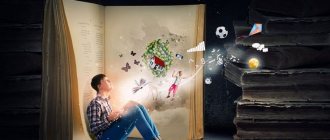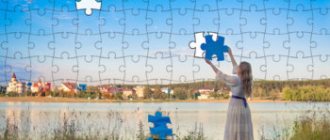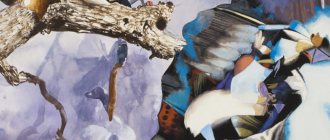Introduction
Creative activity is any kind of human activity that creates something new, no matter whether this created by creative activity is some thing in the external world or a known structure of the mind or feeling that lives and is revealed only in the person himself. All human activity can be divided into 2 main types of actions.
1. The first type of activity can be called reproducing; or reproductive; it can be closely connected with memory, its essence lies in the fact that a person reproduces or repeats previously created and developed methods of behavior, or resurrects traces of previous impressions.
2. In addition to reproductive activity, it is easy to notice another type of activity in human behavior, namely combining or creative activity. Any human activity, the result of which is not the reproduction of impressions or actions that were in his experience, but the consciousness of new images or actions, will belong to this second type of creative or combining behavior.
The purpose of this work is to study psychological literature on the topic of “imagination”.
The goal is to show that imagination really plays a huge role in creative activity.
The object of study is imagination as a mental process.
The subjects are types, techniques for creating images of the imagination, the influence of imagination on human life and creativity.
Features of creative imagination
Creative imagination is a type of thinking in which a person creates new objects or images that have value for humanity. They appear as a result of memory processing by consciousness and with the help of other psychological mechanisms.
Creative development is a necessary part of personality development. This is not just a labor-intensive process that represents a certain value. There are many types of creative activities that require imagination.
I. Concept, types and functions of imagination.
I.1.The concept of imagination.
According to Evald Vasilyevich Ilyenkov, the essence of imagination lies in the ability to “grasp” the whole before the part, in the ability, based on a separate hint, the tendency to build a holistic image. (Quoted from 1). A distinctive feature of imagination is a kind of “departure from reality”, when a new image is built on the basis of a separate sign of reality, and not simply reconstructed existing ideas, which is typical for the functioning of the internal plan of action. (Quoted from 2).
Imagination is a necessary element of human creative activity, expressed in the construction of an image of the products of labor, ensuring the creation of a program of behavior in cases where the problem situation is also characterized by uncertainty. Depending on the various circumstances that characterize a problem situation, the same problem can be solved both with the help of imagination and with the help of thinking. From this we can conclude that the imagination works at that stage of cognition when the uncertainty of the situation is very great. Fantasy allows you to “jump” over some stages of thinking and still imagine the end result.
Imagination is inherent only to man. According to E.V. Ilyenkov: “Fantasy itself, or the power of imagination, is one of not only the most precious, but also the universal, universal abilities that distinguish a person from an animal. Without the power of imagination, it would be impossible to even recognize an old friend if he suddenly grew a beard; it would be impossible even to cross the street through a stream of cars. Humanity, devoid of imagination, would never launch rockets into space.” (Quoted from 3). And according to K. Marx: “The spider performs the operations of a weaver, and the bee, with the restructuring of its wax cells, puts some human architects to shame. But the difference between the worst architect and the best bee is that before he builds a cell of wax, he has already built it in his head. In the process of labor, a result is obtained that was already in a person’s mind at the beginning of this process.” (Quoted in 4).
The neurophysiological basis of imagination is the formation of temporary nervous connections in the sphere of the first and second signaling systems, their dissociation (breakdown into separate elements) and unification into new systems under the influence of various motivations. Imagination is associated with emotions and the activity of subcortical formations of the brain, but recent studies confirm that the physiological mechanisms of imagination are located not only in the cortex, but also in deeper parts of the brain, for example, the hypothalamic-limbic system. It has been experimentally established that when the hypothalamic-limbic system is damaged, a person may experience characteristic mental disorders: the impression arises that his behavior is not regulated by a specific program and consists of a series of separate, isolated acts, which, however, are quite complex and integral in themselves. Under the influence of imagination, corresponding organic changes occur in a person. Thus, by figuratively imagining certain physical actions, you can cause an increase in the work of the heart and respiratory organs.
Imagination processes are analytical-synthetic in nature. Its main tendency is the transformation of ideas (images), which ultimately ensures the creation of a model of a situation that is obviously new and has not previously arisen. When analyzing the mechanism of imagination, it is necessary to emphasize that its essence is the process of transforming ideas, creating new images based on existing ones. Imagination, fantasy is a reflection of reality in new, unexpected, unusual combinations and connections. Lev Semenovich Vygotsky said: “The creative activity of the imagination is directly dependent on the richness and diversity of a person’s previous experience, because experience represents the material from which fantasy structures are created. The richer a person’s experience, the more material his imagination has at his disposal.” (Quoted from 5).
There are several forms of image synthesis:
1. Agglutination - “gluing” of various qualities, properties, parts that are not combined in everyday life (mermaid, amphibious tank);
2. Hyperbolization, which is characterized not only by an increase or decrease in the object (a boy the size of a finger), but also by a change in the number of parts of the object and their displacement (a dragon with 7 heads);
3. Sharpening, emphasizing any features (caricatures, caricatures);
4. Typification, which is characterized by the identification of the essential, repeated in homogeneous facts and their embodiment in a specific image.
The activity of imagination is associated with the formation of a number of moral and psychological qualities of the individual, such as ideological conviction, sense of duty, patriotism, humanity, sensitivity, determination, and perseverance.
I.2. Types of imagination.
Imagination can be of four main types (Fig. 1):
Fig. 1 Main types of imagination
1. Active imagination - characterized by the fact that, using it, a person, of his own free will, by force of will, evokes in himself the appropriate images. Active imagination is a sign of a creative type of personality, which constantly tests its internal capabilities, its knowledge is not static, but is continuously recombined, leading to new results, giving the individual emotional reinforcement for new searches, the creation of new material and spiritual values. Her mental activity is supraconscious and intuitive.
2. Passive imagination lies in the fact that its images arise spontaneously, regardless of the will and desire of a person. Passive imagination can be unintentional or intentional. Unintentional passive imagination occurs with weakening of consciousness, psychosis, disorganization of mental activity, in a semi-drowsy and sleepy state. With deliberate passive imagination, a person arbitrarily forms images of escape from reality-dreams. The unreal world created by a person is an attempt to replace unfulfilled hopes, make up for bereavements, and alleviate mental trauma. This type of imagination indicates a deep intrapersonal conflict.
3. Productive imagination - differs in that in it reality is consciously constructed by a person, and not simply mechanically copied or recreated. At the same time, this reality is creatively transformed in the image. This type of imagination underlies artistic, literary, musical, design and scientific activities. The results of creative imagination can be material and ideal images. An essential criterion for this type of imagination is the social value of its results, penetration into the essence of the depicted aspects of reality, emphasis, and strengthening of the most significant aspects of reality.
4. Reproductive imagination - when used, the task is to reproduce reality as it is, and although there is also an element of fantasy, such imagination is more reminiscent of perception or memory than creativity. For example, when reading literature, when studying a map of the area or historical descriptions, the imagination recreates what is depicted in these books, maps, and stories.
In all these cases, fantasy as a type of imagination plays a positive role. But there are other types of imagination. These are dreams, hallucinations, reveries and daydreams. Dreams can be classified as passive and involuntary forms of imagination. Their true role in human life has not yet been established, although it is known that in human dreams many vital needs are expressed and satisfied, which, for a number of reasons, cannot be realized in life. Hallucinations are fantastic visions that apparently have almost no connection with the reality around a person. Usually they are the result of certain mental or bodily disorders and accompany many painful conditions. Dreams, unlike hallucinations, are a completely normal mental state, representing a fantasy associated with a desire, most often a somewhat idealized future. A dream differs from a daydream in that it is somewhat more realistic and more closely related to reality, i.e. is in principle feasible. Dreams and daydreams occupy a fairly large part of a person's time, especially in youth.
I.3. Functions of imagination and its development
The human mind cannot be in an inactive state, which is why people dream so much. The human brain continues to function even when new information does not enter it, when it does not solve any problems. It is at this time that the imagination begins to work. It has been established that a person, at will, is not able to stop the flow of thoughts, stop the imagination.
In the process of human life, the imagination performs a number of specific functions (Fig. 2), the first of which is to represent reality in images and be able to use them when solving problems. This function of imagination is connected with thinking and is organically included in it.
The second function of imagination is to regulate emotional states. With the help of his imagination, a person is able to at least partially satisfy many needs and relieve the tension generated by them. This vital function is especially emphasized and developed in such a direction of psychology as psychoanalysis.
The third function of imagination is associated with its participation in the voluntary regulation of cognitive processes and human states. With the help of skillfully created images, a person can pay attention to the necessary events; through images, he gains the opportunity to control perceptions, memories, and statements.
The fourth function of imagination is to form an internal plan of action, i.e. the ability to perform them in the mind, manipulating images.
The fifth function of imagination is planning and programming activities, drawing up such programs, assessing their correctness, and the implementation process.
With the help of imagination, a person can control many psychophysiological states of the body and tune it to upcoming activities. There are known facts indicating that with the help of imagination, purely by will, a person can influence organic processes: change the rhythm of breathing, pulse rate, blood pressure, body temperature, etc. These facts underlie auto-training, which is widely used for self-regulation.
With the help of special exercises and techniques, you can develop your imagination. In creative types of work - science, literature, art, engineering, etc., the development of imagination naturally occurs in the pursuit of these types of activities. In autogenic training, the desired result is achieved through a special system of exercises that are aimed at learning through willpower to relax individual muscle groups, for example, muscles of the arms, legs, head, torso, and arbitrarily increase or decrease pressure and body temperature, using imagination exercises for this purpose. heat, cold.
Fig. 2 Specific functions of imagination
II. Imagination as the basis of creative activity in domestic and foreign psychology.
Usually by imagination we mean everything that is not real, that does not correspond to reality. In fact, imagination, as the basis of all creative activity, is equally manifested in all aspects of cultural life, making artistic, scientific and technical creativity possible.
L. S. Vygotsky said that the essence of imagination lies in the fact that it “grabs” the whole before the parts, and builds a complete image based on a hint. A distinctive feature of imagination is a kind of “departure from reality”, the creation of a new image, and not a simple reproduction of known ideas, which is characteristic of memory or an internal plan of action. He wrote: “In this sense, everything that surrounds us and that is made by human hands, the entire world of culture, in contrast to the world of nature, is all a product of human imagination and creativity based on this imagination.”
Z. Freud takes early childhood experiences as the basis for creative processes. Thanks to creative imagination, a child can replace stressful situations that make a strong impression. Z. Freud wrote that the effect of creative behavior is the elimination of oppressive emotions that arise in conflict until a tolerable level is reached. A similar assumption is also shared by E. Chris and K. Kuby
J. Piaget considers imagination as a temporary stage of a distorted reflection of reality. He argues that imagination does not have a positive effect on a child, but on the contrary, it can greatly distort his ideas about reality. Imagination, in his opinion, does not reveal anything new for a child, it only distorts the picture of reality. In the studies of J. Piaget, imagination was associated with the development of the symbolic function in a child and was considered as a special form of representative thinking that allows one to anticipate changes in reality.
The function of imagination - constructing and creating images - has been recognized as the most important human ability. J. Guilford and his followers developed the theory of creative intelligence. Its essence is that, on the basis of factor analysis, individual components of creative imagination were identified, which are recognized as common to children and adults and characterize any form of productive activity:
-intellectual creative initiative – aimed at going beyond the given tasks of the requirements of everyday life;
-breadth of categorization - remoteness of associations, unexpected use of objects, giving them a new functional meaning;
-fluency – richness and variety of associations, the number of connections formed;
- originality – independence, unusualness, wit of the solution in relation to traditional methods.
Due to its specificity, imagination still does not have a stable and generally accepted definition.
L. S. Vygotsky about
“The main feature of the imagination process,” writes E. I. Ignatiev, “in one or another specific practical activity is the transformation and processing of perceptual data and other material of past experience, resulting in new impressions.”
Traditionally (S. L. Rubinshtein, A. V. Petrovsky, A. Ya. Dudetsky) distinguish between active and passive imagination. Passive can be intentional (dreams) or unintentional (dreams, hallucinations). Active imagination is divided into reconstructive, aimed at creating images in accordance with the description, and creative, with the goal of creating new images without relying on a model. According to A.V. Petrovsky, creative imagination involves the independent creation of new images, embodied in original and valuable products of human activity.
According to O. M. Dyachenko, the specificity of the form of organization of imagination lies in the fact that in the imagination there is a merging of the objective content of the image of one object with the objective content of the image of another, emphasizing that this feature of the imagination is revealed when analyzing the imagination of a child involved in various types of activities.
Imagination, connecting two layers of reality, is capable of translating, embodying ideas, figurative ideas about reality, emotional states into metamorphic, symbolic forms, and expressing them indirectly. Thus, O. M. Dyachenko concludes, what is specific to the form of organization of imagination is the transformation of objective contents, when one object reveals the essential characteristics of another.
Imagination in psychology
Imagination is the process of understanding the world around us. The outside world seems to be imprinted in a person’s subconscious. Thanks to this, a person is able to remember ancient and recent events, program, and imagine the future. This process is often called the ability to imagine absent objects in one’s mind, hold their image, and manipulate it in consciousness. Sometimes it is confused with perception, but they are really two different mental processes.
Imagination has the ability to create images based on memory, and not on information from the outside world. It is less real because it has a component of fantasy and dreams. Even the most pragmatic, skeptical, boring people have imagination. It is impossible to assign a person who has completely lost such a function. The behavior of these people is governed by their principles, logic, facts, they always do everything according to the rules. But to say that they have no creative thinking at all or that they never dream is very wrong. It’s just that this is the type of people in whom these processes are not sufficiently developed or they do not use them, or do not know how to use them. Often such people have a monotonous typical life, which is repeated the same way every day, and they act according to a certain algorithm, believing that they do not have time for more. In fact, it is a pity for such people, because their life is boring, they do not use the abilities that are given to them by nature. Creative imagination makes people individual, unique individuals.
Imagination as a mental process has certain functions that help a person become special.
The cognitive function is contained in expanding a person’s horizons, acquiring knowledge, constructing human behavior in an uncertain situation, guided by guesses and considerations.
The prediction function assumes that the properties of imagination help a person imagine the final result of an incomplete action. It is this function that contributes to the formation of dreams and daydreams in people.
The function of understanding is reflected in a person’s ability to guess what a person is currently experiencing, what emotions are overwhelming him, what feelings he is experiencing. Similar to this function is the state of empathy, when a person is able to penetrate into the world of another and understand what worries him.
The protection function assumes that by predicting future events, thinking about the course of actions and the consequences of these actions, a person can prevent troubles and protect himself from possible problems.
The function of self-development is reflected in a person’s ability to fantasize, invent and create.
The function of memory is expressed in a person’s ability to remember past events and recreate images of the past in his head. It is stored in the form of images and ideas.
The above functions are not always fully expressed in all people. Each personality is dominated by a certain function, which often determines the character and behavior of a person. To understand how images and ideas are created, it is necessary to trace the main ways of their creation. Each path is a complex multi-level mental process.
Agglutination is the creation of unreal, completely new, fabulous objects or phenomena that appear under the influence of the properties and appearance of some existing object, evaluating and analyzing the properties of which a person creates an object similar to it. That is, there is an initial object on the basis of which a prototype is formed. This technique is very popular in creating fairy tales or myths.
Emphasis is the process of fixing on one dominant characteristic highlighted in some object (person, object, activity, phenomenon) and exaggerating it. Artists often use accentuation in their works to create cartoons and caricatures.
Typification is the process of identifying the main characteristics in several objects, and creating from them an image that is completely new, but contains a piece of each of them. Using this technique, literary heroes and characters are created.
All of the above imagination techniques are actively used in psychology, creativity, and even scientific activity. For example, in medicine, new drugs are created based on existing ones. Also, modern technology, electronics, gadgets, inventions were developed on the basis of previously existing knowledge, schemes, theories and skills. By collecting the most important information from them and processing it, scientists get a completely new product. If people lacked imagination, humanity would not be able to progress in all areas and activities.
Imagination as a mental process involves the creation of new images based on existing existing experience. The ideas manifested in images in a person’s head have not yet begun to be realized, do not exist, but there is a possibility that in the future they can be brought to life. This process is based on the reformulation of the subject’s information and impressions. The more the situation seems incomprehensible and complex, the more the imagination process is involved. This process is of considerable importance in human professional activity. It also greatly influences feelings and emotions, and plays a big role in personality development.
In the creative and work process, imagination allows the individual to regulate and manage her activities, as well as control her speech, emotions, attention and memory. Helps create and use images of reality. It improves a person’s psychological state, prevents stress and depression. With the help of imagination, an individual is able to plan his future activities in his mind by manipulating images. Imagination and individuality are criteria for assessing a person’s talent and abilities, which is important in work life.
A person reflects the surrounding reality mainly in a figurative way. An image is a non-static phenomenon; it tends to constantly change. This process has a dynamic connection with the objects of the surrounding reality. Consequently, imagination is not some kind of abstraction, but a concrete process associated with the real mental activity of the subject. This activity is also dynamic in nature.
Imagination is the process of self-knowledge of a person, the disclosure of his abilities, other people and the world around him, and the events taking place. This is a special form of the human psyche, occupying a place between perception, memory and thinking processes. Visual-figurative thinking and imagination complement each other; imagination is its basis and makes it possible to show resourcefulness in an unfamiliar situation, to find a solution to a problem without using any action.
II.1. Imagination and creativity.
The role of imagination in the creative process cannot be overestimated. Creativity is closely related to all mental processes, including imagination. The degree of development of imagination and its characteristics are no less important for creativity than, say, the degree of development of thinking. Directly indicates the emergence of imagination from the very essence of the game, and not as a consequence of the manifestation of the child’s behavioral characteristics in it. The game gives birth to other types of activities that are essential for the development of creative imagination (drawing, dramatization, writing). But with a common origin from the game, each type of productive activity has its own specific characteristics, which lies in the fact that their implementation allows you to directly set a creative task (invent, compose, do it yourself). This allows you to most fully actualize your imagination and fully express your creative potential. Vygotsky identified four forms of connection between imagination and reality:
- The first form is that every creation of the imagination is always built from the reality contained in a person’s previous experience. “Creative activity,” the scientist writes, “is directly dependent on the richness and diversity of the child’s previous experience, because this experience represents the material from which fantasy structures are created. The richer a person’s experience, the more material his imagination has at his disposal.”
— L. S. Vygotsky sees the second form of connection between imagination and reality in the adequacy of the finished product of activity to some phenomenon of reality. In this sense, a person can imagine something that he has not seen, imagine from someone else’s story or description something that did not exist in his personal experience.
— The third form of connection is emotional connection. Characterizing it, L. S. Vygotsky notes that emotion has the ability to select impressions, images, thoughts that are consonant with the mood possessing a person at a given moment. However, imagination also influences feelings. Fantasy images evoke not imaginary, but real feelings.
— The last form of connection between imagination and reality allows us to conclude that the process of children's creativity should be used to further enrich fantasy and creativity. At the same time, it is important to remember that a child is influenced not only by his own work, but also by works created by other children.
The process of development of creative imagination was studied by such scientists as A.N. Leontiev, P.Ya. Galperin, N.N. Poddyakov, O. M. Dyachenko, L. A. Wenger, E. E. Kravtsova, V. T. Kudryavtseva, etc. Their studies emphasize the idea that creative imagination is associated with significant novelty and uncertainty of the cognizable situation. Resolving such situations involves unlimited use of a variety of possible methods.
Prominent psychologists O. M. Dyachenko and L. A. Wenger identified the main directions for the development of creative imagination:
- realism of imagination;
-the ability to see the whole before the parts;
- supra-situational – transformative nature of creative solutions.
Thus, the English scientist G. Wallace managed to identify four stages of the creative process, each of which can be detailed and requires specific methods and techniques of guidance on the part of the teacher.
1.preparation (idea generation);
2. Maturation (concentration of knowledge directly and indirectly related to a given problem, obtaining missing information);
3. Insight (intuitively grasping the desired result);
4. Check.
Until now, many important questions for understanding the nature of imagination remain unanswered, especially with regard to the early stages of the development of creativity. As soon as we talk about the origins of creativity, psychologists begin to contradict each other. In foreign psychology there are different points of view on this matter.









